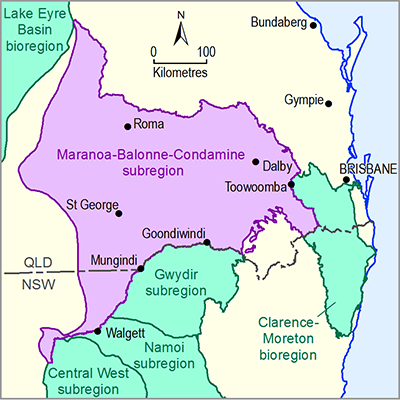Summary
No-flow boundary conditions are assigned to the mapped geological boundaries in the north-west and north-east where the Surat and Bowen geological basins are absent and along the Nebine Ridge (western model boundary). MODFLOW General Head Boundary cells are used to simulate groundwater flows in the east across the Kumbarilla Ridge and in the south along the Queensland state border. Modelled drawdown indicates that lateral boundary conditions are sufficiently remote from current and future coal resource development to reduce their impact on the model predictions.
MODFLOW Drain cells are used to establish topographic control of groundwater levels and to calculate net recharge. Net recharge is equivalent to the modelled flux to the deeper confined system and represents the proportion of potential or watertable recharge that is rejected via shallow groundwater systems and/or surface watercourses. Net recharge values are estimated for 20 recharge zones during steady-state model calibration using upper and lower estimates of long-term mean recharge. Evapotranspiration is not modelled explicitly in the Office of Groundwater Impact Assessment (OGIA) model, which means that hydrological response variables related to terrestrial groundwater-dependent ecosystems, cannot be predicted by the OGIA model.
The MODFLOW Wells package is used to represent all groundwater extractions from approximately 19,000 bores, including licensed volumetric entitlements, stock and domestic and conventional oil and gas abstractions. The MODFLOW EVT package is used to represent groundwater extraction associated with coal seam gas (CSG) production by allowing extraction rates to gradually reduce as the head falls toward a user-defined extinction depth. Total groundwater extractions in the OGIA model are about 215,000 ML/year for non-CSG production and about 95,000 ML/year for CSG production over the life of the industry.
It is assumed that all surface watercourses act as discharge boundaries with respect to the underlying aquifer. The MODFLOW River package is used to represent surface water – groundwater interactions in the major alluvial systems and watercourses. Using River cells means that changes to baseflow volumes from groundwater level drawdown can be estimated for the major alluvial systems and watercourses. The more-detailed Condamine Model is used to estimate impacts on groundwater levels in the Condamine Alluvium that result from the change in flow from the Condamine Alluvium to the Walloon Coal Measures predicted by the regional model. Temporary watercourses that are losing or losing – disconnected with respect to the underlying aquifer are represented in the OGIA model by Drain cells.

Product Finalisation date
- 2.6.2.1 Methods
- 2.6.2.2 Review of existing models
- 2.6.2.3 Model development
- 2.6.2.4 Boundary and initial conditions
- 2.6.2.5 Implementation of coal resource development pathway
- 2.6.2.6 Parameterisation
- 2.6.2.7 Observations and predictions
- 2.6.2.8 Uncertainty analysis
- 2.6.2.9 Limitations
- Glossary
- Citation
- Acknowledgements
- Contributors to the Technical Programme
- About this technical product
